Writing Studio
Common transition words and phrases.
In an effort to make our handouts more accessible, we have begun converting our PDF handouts to web pages. Download this page as a PDF: Transitions Return to Writing Studio Handouts
Transitions clarify the logic of your argument by orienting your reader as you develop ideas between sentences and paragraphs. These tools should alert readers to shifts in your argument while and also maintain the smoothness and clarity of your prose. Below, you’ll find some of the most commonly used transition categories and examples of each. Depending on the example, these suggestions may be within sentences or at the beginning of sentences.

Transitions by Category
1. addition.
Use when presenting multiple ideas that flow in the same direction, under the same heading/ idea also, another, finally, first, first of all, for one thing, furthermore, in addition, last of all, likewise, moreover, next, and, second, the third reason
2. Sequence/ Order
Use to suggest a temporal relationship between ideas; places evidence in sequence first, second (etc.), next, last, finally, first of all, concurrently, immediately, prior to, then, at that time, at this point, previously, subsequently, and then, at this time, thereafter, previously, soon, before, after, followed by, after that, next, before, after, meanwhile, formerly, finally, during
3. Contrast
Use to demonstrate differences between ideas or change in argument direction but, however, in contrast, on the other hand, on the contrary, yet, differ, difference, balanced against, differing from, variation, still, on the contrary, unlike, conversely, otherwise, on the other hand, however
4. Exception
Use to introduce an opposing idea however, whereas, on the other hand, while, instead, in spite of, yet, despite, still, nevertheless, even though, in contrast, but, but one could also say…
5. Comparison
Use to demonstrate similarities between ideas that may not be under the same subject heading or within the same paragraph like, likewise, just, in a different way / sense, whereas, like, equally, in like manner, by comparison, similar to, in the same way, alike, similarity, similarly, just as, as in a similar fashion, conversely
6. Illustration
Use to develop or clarify an idea, to introduce examples, or to show that the second idea is subordinate to the first for example, to illustrate, on this occasion, this can be seen, in this case, specifically, once, to illustrate, when/where, for instance, such as, to demonstrate, take the case of, in this case
7. Location
Use to show spatial relations next to, above, below, beneath, left, right, behind, in front, on top, within
8. Cause and Effect
Use to show that one idea causes, or results from, the idea that follows or precedes it because, therefore, so that, cause, reason, effect, thus, consequently, since, as a result, if…then, result in
9. Emphasis
Use to suggest that an idea is particularly important to your argument important to note, most of all, a significant factor, a primary concern, a key feature, remember that, pay particular attention to, a central issue, the most substantial issue, the main value, a major event, the chief factor, a distinctive quality, especially valuable, the chief outcome, a vital force, especially relevant, most noteworthy, the principal item, above all, should be noted
10. Summary or Conclusion
Use to signal that what follows is summarizing or concluding the previous ideas; in humanities papers, use these phrases sparingly. to summarize, in short, in brief, in sum, in summary, to sum up, in conclusion, to conclude, finally
Some material adapted from Cal Poly Pomona College Reading Skills Program and “ Power Tools for Technical Communication .”
Writing Effective Sentence Transitions (Advanced)
Transitions are the rhetorical tools that clarify the logic of your argument by orienting your reader as you develop ideas between sentences and paragraphs. The ability to integrate sentence transitions into your prose, rather than simply throwing in overt transition signals like “in addition,” indicates your mastery of the material. (Note: The visibility of transitions may vary by discipline; consult with your professor to get a better sense of discipline or assignment specific expectations.)
Transition Signals
Transition signals are words or phrases that indicate the logic connecting sets of information or ideas. Signals like therefore, on the other hand, for example, because, then, and afterwards can be good transition tools at the sentence and paragraph level. When using these signals, be conscious of the real meaning of these terms; they should reflect the actual relationship between ideas.
Review Words
Review words are transition tools that link groups of sentences or whole paragraphs. They condense preceding discussion into a brief word or phrase. For example: You’ve just completed a detailed discussion about the greenhouse effect. To transition to the next topic, you could use review words like “this heat-trapping process” to refer back to the green house effect discussion. The relative ability to determine a cogent set of review words might signal your own understanding of your work; think of review words as super-short summaries of key ideas.
Preview words
Preview words condense an upcoming discussion into a brief word or phrase. For example: You’ve just explained how heat is trapped in the earth’s atmosphere. Transitioning to the theory that humans are adding to that effect, you could use preview words like “sources of additional CO2 in the atmosphere include” to point forward to that discussion.
Transition Sentences
The strongest and most sophisticated tools, transition sentences indicate the connection between the preceding and upcoming pieces of your argument. They often contain one or more of the above transition tools. For example: You’ve just discussed how much CO2 humans have added to the atmosphere. You need to transition to a discussion of the effects. A strong set of transition sentences between the two sections might sound like this:
“These large amounts of CO2 added to the atmosphere may lead to a number of disastrous consequences for residents of planet earth. The rise in global temperature that accompanies the extra CO2 can yield effects as varied as glacial melting and species extinction.”
In the first sentence, the review words are “These large amounts of CO2 added to the atmosphere”; the preview words are “number of disastrous consequences”; the transition signals are “may lead to.” The topic sentence of the next paragraph indicates the specific “disastrous consequences” you will discuss.
If you don’t see a way to write a logical, effective transition between sentences, ideas or paragraphs, this might indicate organizational problems in your essay; you might consider revising your work.
Some material adapted from Cal Poly Pomona College Reading Skills Program and “ Power Tools for Technical Communication .”
Last revised: 07/2008 | Adapted for web delivery: 05/2021
In order to access certain content on this page, you may need to download Adobe Acrobat Reader or an equivalent PDF viewer software.
Have a language expert improve your writing
Run a free plagiarism check in 10 minutes, generate accurate citations for free.
- Knowledge Base
- Academic writing
- Transition Words & Phrases | List & Examples
Transition Words & Phrases | List & Examples
Published on May 29, 2020 by Jack Caulfield . Revised on August 23, 2023.
Transition words and phrases (also called linking words, connecting words, or transitional words) are used to link together different ideas in your text. They help the reader to follow your arguments by expressing the relationships between different sentences or parts of a sentence.
The proposed solution to the problem did not work. Therefore , we attempted a second solution. However , this solution was also unsuccessful.
For clear writing, it’s essential to understand the meaning of transition words and use them correctly.
Instantly correct all language mistakes in your text
Upload your document to correct all your mistakes in minutes

Table of contents
When and how to use transition words, types and examples of transition words, common mistakes with transition words, other interesting articles.
Transition words commonly appear at the start of a new sentence or clause (followed by a comma ), serving to express how this clause relates to the previous one.
Transition words can also appear in the middle of a clause. It’s important to place them correctly to convey the meaning you intend.
Example text with and without transition words
The text below describes all the events it needs to, but it does not use any transition words to connect them. Because of this, it’s not clear exactly how these different events are related or what point the author is making by telling us about them.
If we add some transition words at appropriate moments, the text reads more smoothly and the relationship among the events described becomes clearer.
Germany invaded Poland on September 1, 1939. Consequently , France and the United Kingdom declared war on Germany. The Soviet Union initially worked with Germany in order to partition Poland. However , Germany invaded the Soviet Union in 1941.
Don’t overuse transition words
While transition words are essential to clear writing, it’s possible to use too many of them. Consider the following example, in which the overuse of linking words slows down the text and makes it feel repetitive.
In this case the best way to fix the problem is to simplify the text so that fewer linking words are needed.
The key to using transition words effectively is striking the right balance. It is difficult to follow the logic of a text with no transition words, but a text where every sentence begins with a transition word can feel over-explained.
Receive feedback on language, structure, and formatting
Professional editors proofread and edit your paper by focusing on:
- Academic style
- Vague sentences
- Style consistency
See an example

There are four main types of transition word: additive, adversative, causal, and sequential. Within each category, words are divided into several more specific functions.
Remember that transition words with similar meanings are not necessarily interchangeable. It’s important to understand the meaning of all the transition words you use. If unsure, consult a dictionary to find the precise definition.
Additive transition words
Additive transition words introduce new information or examples. They can be used to expand upon, compare with, or clarify the preceding text.
Adversative transition words
Adversative transition words always signal a contrast of some kind. They can be used to introduce information that disagrees or contrasts with the preceding text.
Causal transition words
Causal transition words are used to describe cause and effect. They can be used to express purpose, consequence, and condition.
Sequential transition words
Sequential transition words indicate a sequence, whether it’s the order in which events occurred chronologically or the order you’re presenting them in your text. They can be used for signposting in academic texts.
Transition words are often used incorrectly. Make sure you understand the proper usage of transition words and phrases, and remember that words with similar meanings don’t necessarily work the same way grammatically.
Misused transition words can make your writing unclear or illogical. Your audience will be easily lost if you misrepresent the connections between your sentences and ideas.
Confused use of therefore
“Therefore” and similar cause-and-effect words are used to state that something is the result of, or follows logically from, the previous. Make sure not to use these words in a way that implies illogical connections.
- We asked participants to rate their satisfaction with their work from 1 to 10. Therefore , the average satisfaction among participants was 7.5.
The use of “therefore” in this example is illogical: it suggests that the result of 7.5 follows logically from the question being asked, when in fact many other results were possible. To fix this, we simply remove the word “therefore.”
- We asked participants to rate their satisfaction with their work from 1 to 10. The average satisfaction among participants was 7.5.
Starting a sentence with also , and , or so
While the words “also,” “and,” and “so” are used in academic writing, they are considered too informal when used at the start of a sentence.
- Also , a second round of testing was carried out.
To fix this issue, we can either move the transition word to a different point in the sentence or use a more formal alternative.
- A second round of testing was also carried out.
- Additionally , a second round of testing was carried out.
Transition words creating sentence fragments
Words like “although” and “because” are called subordinating conjunctions . This means that they introduce clauses which cannot stand on their own. A clause introduced by one of these words should always follow or be followed by another clause in the same sentence.
The second sentence in this example is a fragment, because it consists only of the “although” clause.
- Smith (2015) argues that the period should be reassessed. Although other researchers disagree.
We can fix this in two different ways. One option is to combine the two sentences into one using a comma. The other option is to use a different transition word that does not create this problem, like “however.”
- Smith (2015) argues that the period should be reassessed, although other researchers disagree.
- Smith (2015) argues that the period should be reassessed. However , other researchers disagree.
And vs. as well as
Students often use the phrase “ as well as ” in place of “and,” but its usage is slightly different. Using “and” suggests that the things you’re listing are of equal importance, while “as well as” introduces additional information that is less important.
- Chapter 1 discusses some background information on Woolf, as well as presenting my analysis of To the Lighthouse .
In this example, the analysis is more important than the background information. To fix this mistake, we can use “and,” or we can change the order of the sentence so that the most important information comes first. Note that we add a comma before “as well as” but not before “and.”
- Chapter 1 discusses some background information on Woolf and presents my analysis of To the Lighthouse .
- Chapter 1 presents my analysis of To the Lighthouse , as well as discussing some background information on Woolf.
Note that in fixed phrases like “both x and y ,” you must use “and,” not “as well as.”
- Both my results as well as my interpretations are presented below.
- Both my results and my interpretations are presented below.
Use of and/or
The combination of transition words “and/or” should generally be avoided in academic writing. It makes your text look messy and is usually unnecessary to your meaning.
First consider whether you really do mean “and/or” and not just “and” or “or.” If you are certain that you need both, it’s best to separate them to make your meaning as clear as possible.
- Participants were asked whether they used the bus and/or the train.
- Participants were asked whether they used the bus, the train, or both.
Archaic transition words
Words like “hereby,” “therewith,” and most others formed by the combination of “here,” “there,” or “where” with a preposition are typically avoided in modern academic writing. Using them makes your writing feel old-fashioned and strained and can sometimes obscure your meaning.
- Poverty is best understood as a disease. Hereby , we not only see that it is hereditary, but acknowledge its devastating effects on a person’s health.
These words should usually be replaced with a more explicit phrasing expressing how the current statement relates to the preceding one.
- Poverty is best understood as a disease. Understanding it as such , we not only see that it is hereditary, but also acknowledge its devastating effects on a person’s health.
Using a paraphrasing tool for clear writing
With the use of certain tools, you can make your writing clear. One of these tools is a paraphrasing tool . One thing the tool does is help your sentences make more sense. It has different modes where it checks how your text can be improved. For example, automatically adding transition words where needed.
If you want to know more about AI for academic writing, AI tools, or writing rules make sure to check out some of our other articles with explanations and examples or go directly to our tools!
Academic Writing
- Avoiding repetition
- Effective headings
- Passive voice
- Taboo words
- Deep learning
- Generative AI
- Machine learning
- Reinforcement learning
- Supervised vs. unsupervised learning
(AI) Tools
- Grammar Checker
- Paraphrasing Tool
- Text Summarizer
- AI Detector
- Plagiarism Checker
- Citation Generator
Cite this Scribbr article
If you want to cite this source, you can copy and paste the citation or click the “Cite this Scribbr article” button to automatically add the citation to our free Citation Generator.
Caulfield, J. (2023, August 23). Transition Words & Phrases | List & Examples. Scribbr. Retrieved April 2, 2024, from https://www.scribbr.com/academic-writing/transition-words/
Is this article helpful?

Jack Caulfield
Other students also liked, using conjunctions | definition, rules & examples, transition sentences | tips & examples for clear writing, how to write topic sentences | 4 steps, examples & purpose, "i thought ai proofreading was useless but..".
I've been using Scribbr for years now and I know it's a service that won't disappoint. It does a good job spotting mistakes”
33 Transition Words and Phrases
Transitional terms give writers the opportunity to prepare readers for a new idea, connecting the previous sentence to the next one.
Many transitional words are nearly synonymous: words that broadly indicate that “this follows logically from the preceding” include accordingly, therefore, and consequently . Words that mean “in addition to” include moreover, besides, and further . Words that mean “contrary to what was just stated” include however, nevertheless , and nonetheless .
as a result : THEREFORE : CONSEQUENTLY
The executive’s flight was delayed and they accordingly arrived late.
in or by way of addition : FURTHERMORE
The mountain has many marked hiking trails; additionally, there are several unmarked trails that lead to the summit.
at a later or succeeding time : SUBSEQUENTLY, THEREAFTER
Afterward, she got a promotion.
even though : ALTHOUGH
She appeared as a guest star on the show, albeit briefly.
in spite of the fact that : even though —used when making a statement that differs from or contrasts with a statement you have just made
They are good friends, although they don't see each other very often.
in addition to what has been said : MOREOVER, FURTHERMORE
I can't go, and besides, I wouldn't go if I could.
as a result : in view of the foregoing : ACCORDINGLY
The words are often confused and are consequently misused.
in a contrasting or opposite way —used to introduce a statement that contrasts with a previous statement or presents a differing interpretation or possibility
Large objects appear to be closer. Conversely, small objects seem farther away.
used to introduce a statement that is somehow different from what has just been said
These problems are not as bad as they were. Even so, there is much more work to be done.
used as a stronger way to say "though" or "although"
I'm planning to go even though it may rain.
in addition : MOREOVER
I had some money to invest, and, further, I realized that the risk was small.
in addition to what precedes : BESIDES —used to introduce a statement that supports or adds to a previous statement
These findings seem plausible. Furthermore, several studies have confirmed them.
because of a preceding fact or premise : for this reason : THEREFORE
He was a newcomer and hence had no close friends here.
from this point on : starting now
She announced that henceforth she would be running the company.
in spite of that : on the other hand —used when you are saying something that is different from or contrasts with a previous statement
I'd like to go; however, I'd better not.
as something more : BESIDES —used for adding information to a statement
The city has the largest population in the country and in addition is a major shipping port.
all things considered : as a matter of fact —used when making a statement that adds to or strengthens a previous statement
He likes to have things his own way; indeed, he can be very stubborn.
for fear that —often used after an expression denoting fear or apprehension
He was concerned lest anyone think that he was guilty.
in addition : ALSO —often used to introduce a statement that adds to and is related to a previous statement
She is an acclaimed painter who is likewise a sculptor.
at or during the same time : in the meantime
You can set the table. Meanwhile, I'll start making dinner.
BESIDES, FURTHER : in addition to what has been said —used to introduce a statement that supports or adds to a previous statement
It probably wouldn't work. Moreover, it would be very expensive to try it.
in spite of that : HOWEVER
It was a predictable, but nevertheless funny, story.
in spite of what has just been said : NEVERTHELESS
The hike was difficult, but fun nonetheless.
without being prevented by (something) : despite—used to say that something happens or is true even though there is something that might prevent it from happening or being true
Notwithstanding their youth and inexperience, the team won the championship.
if not : or else
Finish your dinner. Otherwise, you won't get any dessert.
more correctly speaking —used to introduce a statement that corrects what you have just said
We can take the car, or rather, the van.
in spite of that —used to say that something happens or is true even though there is something that might prevent it from happening or being true
I tried again and still I failed.
by that : by that means
He signed the contract, thereby forfeiting his right to the property.
for that reason : because of that
This tablet is thin and light and therefore very convenient to carry around.
immediately after that
The committee reviewed the documents and thereupon decided to accept the proposal.
because of this or that : HENCE, CONSEQUENTLY
This detergent is highly concentrated and thus you will need to dilute it.
while on the contrary —used to make a statement that describes how two people, groups, etc., are different
Some of these species have flourished, whereas others have struggled.
NEVERTHELESS, HOWEVER —used to introduce a statement that adds something to a previous statement and usually contrasts with it in some way
It was pouring rain out, yet his clothes didn’t seem very wet.
Word of the Day
See Definitions and Examples »
Get Word of the Day daily email!
Games & Quizzes

Usage Notes
Prepositions, ending a sentence with, is 'irregardless' a real word, 8 more grammar terms you used to know: special verb edition, point of view: it's personal, 31 useful rhetorical devices, grammar & usage, 7 pairs of commonly confused words, did we change the definition of 'literally', more commonly mispronounced words, the tangled history of 'it's' and 'its', more commonly misspelled words, 10 bird names that sound like insults (and sometimes are), eavesdrop, fiasco, and 8 more words with surprising origins, 'when pigs fly' and other barnyard idioms, the words of the week - apr. 5, 12 bird names that sound like compliments.

Addition (Basic)
Addition (Multi-Digit)
Algebra & Pre-Algebra
Comparing Numbers
Daily Math Review
Division (Basic)
Division (Long Division)
Hundreds Charts
Measurement
Multiplication (Basic)
Multiplication (Multi-Digit)
Order of Operations
Place Value
Probability
Skip Counting
Subtraction
Telling Time
Word Problems (Daily)
More Math Worksheets
Reading Comprehension
Reading Comprehension Gr. 1
Reading Comprehension Gr. 2
Reading Comprehension Gr. 3
Reading Comprehension Gr. 4
Reading Comprehension Gr. 5
Reading Comprehension Gr. 6
Reading & Writing
Reading Worksheets
Cause & Effect
Fact & Opinion
Fix the Sentences
Graphic Organizers
Synonyms & Antonyms
Writing Prompts
Writing Story Pictures
Writing Worksheets
More ELA Worksheets
Consonant Sounds
Vowel Sounds
Consonant Blends
Consonant Digraphs
Word Families
More Phonics Worksheets
Early Literacy
Build Sentences
Sight Word Units
Sight Words (Individual)
More Early Literacy
Punctuation
Subjects and Predicates
More Grammar Worksheets
Spelling Lists
Spelling Grade 1
Spelling Grade 2
Spelling Grade 3
Spelling Grade 4
Spelling Grade 5
Spelling Grade 6
More Spelling Worksheets
Chapter Books
Charlotte's Web
Magic Tree House #1
Boxcar Children
More Literacy Units
Animal (Vertebrate) Groups
Butterfly Life Cycle
Electricity
Matter (Solid, Liquid, Gas)
Simple Machines
Space - Solar System
More Science Worksheets
Social Studies
Maps (Geography)
Maps (Map Skills)
More Social Studies
Mother's Day
Father's Day
More Holiday Worksheets
Puzzles & Brain Teasers
Brain Teasers
Logic: Addition Squares
Mystery Graph Pictures
Number Detective
Lost in the USA
More Thinking Puzzles
Teacher Helpers
Teaching Tools
Award Certificates
More Teacher Helpers
Pre-K and Kindergarten
Alphabet (ABCs)
Numbers and Counting
Shapes (Basic)
More Kindergarten

Worksheet Generator
Word Search Generator
Multiple Choice Generator
Fill-in-the-Blanks Generator
More Generator Tools
Full Website Index
Transition Words
Transition words help a reader transition smoothly between sentences or ideas. Examples of transition words include: similarly, therefore, however, although, first, finally, meanwhile. Here you'll find a collection of PDF worksheets for teaching students to write sentences with transition words. These activities align with Common Core Standard W.4.3.c and W.5.2.c.
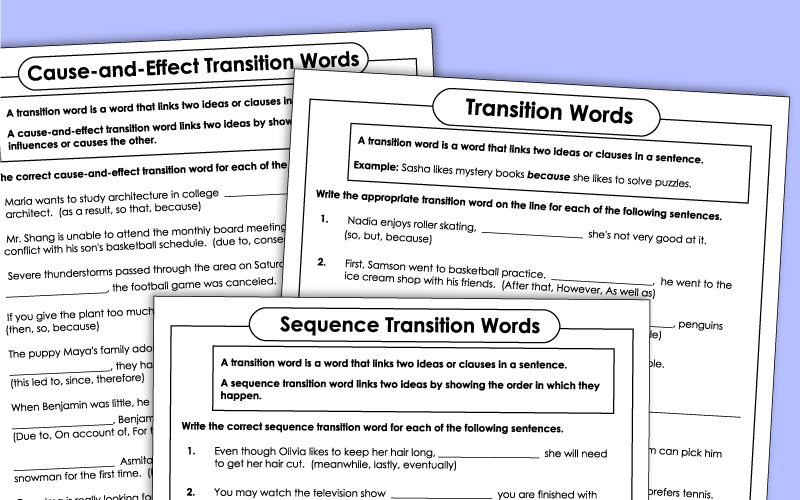
Sequence: Transition Words

Logged in members can use the Super Teacher Worksheets filing cabinet to save their favorite worksheets.
Quickly access your most used files AND your custom generated worksheets!
Please login to your account or become a member and join our community today to utilize this helpful feature.

Cause & Effect: Transition Words
Opinions & reasons: linking words, transition words (mixed).
This page has a collection of worksheets on sequencing and ordering events.
Sample Worksheet Images
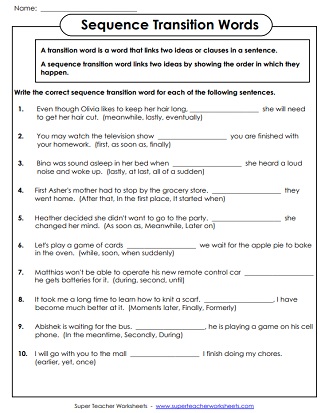
PDF with answer key:
PDF no answer key:
Reading Worksheets, Spelling, Grammar, Comprehension, Lesson Plans
Identify the Transition Words
About this worksheet:.
Transition words are used in a sentence to connect two ideas. They join clauses or sentences together to show a difference or a connection. In this printable activity, students circle the transition words and phrases in the sentences below. Great for middle school but can be used where appropriate.
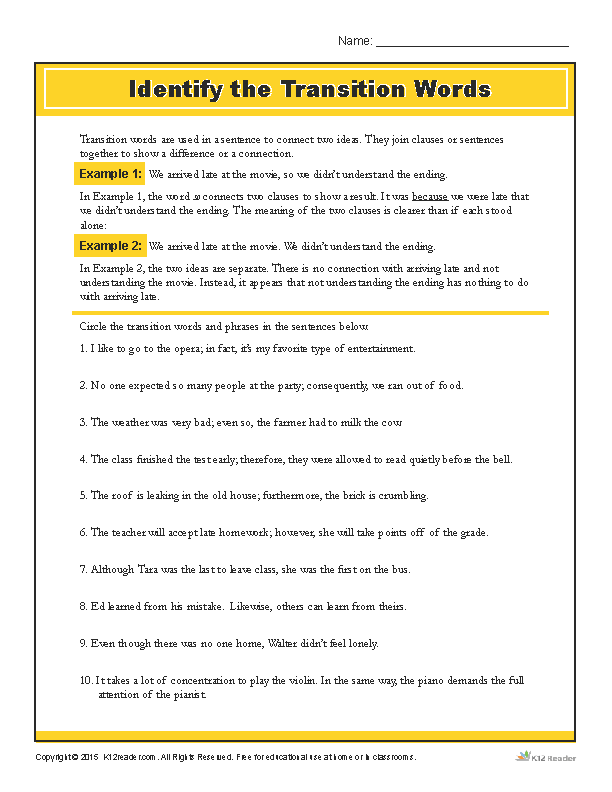
- My Storyboards
Transition Words Templates
Customize transition words templates.

If you're assigning this to your students, copy the worksheet to your account and save. When creating an assignment, just select it as a template!

Utilizing Transition Words Worksheets in The Classroom
In the realm of effective writing, the power of transition words cannot be overlooked. These linguistic tools seamlessly connect ideas, provide coherence, and elevate the quality of students' writing.
What are Transition Words?
Transition words establish connections and relationships between different parts of a text, guiding the reader through the logical flow of thoughts. They signal shifts in thought, indicate relationships between sentences, expressions, and paragraphs, and enhance clarity and organization in what we write. Common examples include "however," "in addition," "therefore," "finally", "for instance", "similarly", and "for example." Transition words are essential for effective communication and writing, improving the coherence and flow of information in a text.
The Importance of Teaching Transition Words
Teaching transition words is fundamental to nurturing students' writing skills. A word or a phrase can act as a bridge between sentences and paragraphs, facilitating smooth transitions and guiding readers through the logical flow of ideas. By instilling an understanding of different transition words and their appropriate usage, educators equip children with a powerful tool to effectively express their thoughts. This not only enhances the clarity and coherence of their writing but also cultivates their ability to complete and connect ideas.
Different Transition Words and Their Impact
Transition words come in various forms, each serving a unique purpose in writing. Common transition words include "however," "moreover," "therefore," and "in addition." These words and phrases fall into several categories, such as addition, contrast, cause and effect, time, comparison, and conclusion. By incorporating a wide range of transition words, students can express complex relationships between ideas, illustrate examples, establish contrasts, and conclude their thoughts effectively. A multifaceted understanding of transition words empowers students to craft compelling essays and narratives.
Benefits of Using Transition Words Worksheets
Transition words worksheets offer a multitude of benefits in the classroom setting. Firstly, they facilitate a comprehensive understanding of transition words by providing targeted practice and reinforcement. Free transition words worksheets can be easily accessed online, catering to the diverse needs of students. Utilizing worksheets, such as transition words fill-in-the-blank worksheets or transition words worksheets for kids, enables students to apply their knowledge in practical exercises. These worksheets engage students actively, deepening their comprehension and fostering mastery of transition words.
How to Teach Transition Words
Teaching transition words requires a systematic approach to ensure effective learning. Educators can begin by introducing the concept of transition words, highlighting their role in connecting ideas. Providing transition words examples and discussing their usage in different contexts cultivates students' understanding. Interactive activities, such as group discussions or writing exercises, encourage students to apply transition words to their own writing. By integrating transition words worksheets into the curriculum, teachers provide valuable opportunities for students to practice and reinforce their skills.
Practical Classroom Strategies
To maximize the impact of transition words worksheets, educators can implement various strategies in the classroom. By focusing on cause-and-effect relationships, teachers can guide students to recognize how transition words establish connections between ideas. Offering timely feedback and assessment on completed worksheets enables students to gauge their progress and make necessary improvements. Incorporating transitional words into writing prompts or essay assignments encourages students to apply their knowledge in real-world scenarios. Additionally, providing differentiated worksheets tailored to individual student needs ensures a personalized learning experience that fosters growth and development.
Tips for Creating a Transition Words and Phrases Worksheet
- Define Learning Objectives: Identify the specific objectives for the worksheet, considering grade level and focus areas like transition words for essays.
- Select Relevant Transition Words: Choose a range of transition words and phrases, including examples from different categories like addition, contrast, cause and effect, and conclusion.
- Structure the Worksheet: Decide on the format, such as multiple-choice, fill-in-the-blank, or matching exercises.
- Provide Clear Instructions: Clearly explain how to use transition words and phrases appropriately within the given context.
- Create Engaging Exercises: Design activities that demonstrate students' understanding of transition words, including sentence-level and paragraph-level exercises.
- Include Examples: Provide relevant examples of transition words used in sentences or paragraphs.
- Differentiate Activities: Cater to diverse student needs by including differentiated exercises for various proficiency levels.
- Incorporate Visuals: Use visuals like diagrams or charts to illustrate the relationships between ideas and the correct use of transition words.
By following these steps, you can create a concise and effective transition words and phrases worksheet that helps students understand and use transition words in their essays and other written work.
Even More Storyboard That Resources and Free Printables
- Worksheet Templates
- Social Stories for Transitions
- Syllables Worksheets
- Active Reading Worksheet
How to Make a Transition Words Worksheet
Choose one of the premade templates.
We have lots of templates to choose from. Take a look at our example for inspiration!
Click on “Copy Template”
Once you do this, you will be directed to the storyboard creator.
Give Your Worksheet a Name!
Be sure to call it something related to the topic so that you can easily find it in the future.
Edit Your Worksheet
This is where you will include directions, specific images, and make any aesthetic changes that you would like. The options are endless!
Click "Save and Exit"
When you are finished, click this button in the lower right hand corner to exit your storyboard.
From here you can print on paper in Word, download as a PDF format, attach it to an assignment and use it digitally, and more!
Happy Creating!
Frequently Asked Questions About Transition Words
Are there specific transition words that are commonly used in essays.
Yes, there are specific transition words that are commonly used in essays. These include linking words such as "however," "moreover," "therefore," "in addition," "for example," and "on the other hand." These words and phrases help convey different relationships between ideas, such as similarities, differences, addition, cause and effect, and illustration.
Can transition words be used within paragraphs, or are they only used between paragraphs?
Transition words are versatile tools that enhance writing by establishing connections both within and between paragraphs and two ideas. Their primary purpose is to ensure flow and coherence. Within a paragraph, transition words like "furthermore" and "moreover" introduce additional information or examples, while "however" and "on the other hand" present contrasting ideas. Words like "therefore" and "thus" indicate cause and effect relationships or draw conclusions. It can be a challenge to figure out how to teach transition words to kids, but incorporating a transition words worksheet for kids from the beginning can make the process more engaging and effective.
Can using transition words worksheets improve students' writing skills?
Yes, using transition words worksheets can help improve students' writing skills. Regular practice with these worksheets allows students to develop a deeper understanding of transition words, incorporate them effectively into their writing, and enhance the coherence and clarification of their compositions.
Try 1 Month For
30 Day Money Back Guarantee New Customers Only Full Price After Introductory Offer
Learn more about our Department, School, and District packages

- Thousands of images
- Custom layouts, scenes, characters
- And so much more!!
Create a Storyboard

Transition Words Worksheets
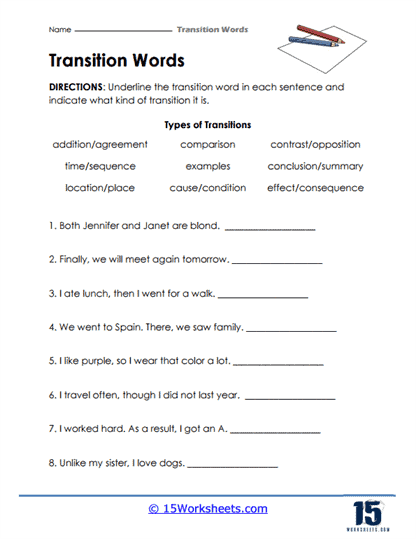
Types Of Transitions
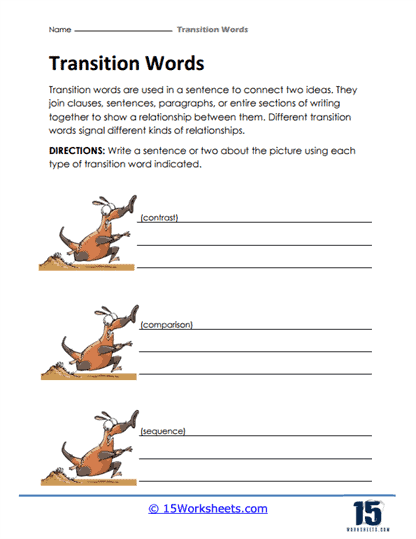
A Sentence Or Two

Sort Into Columns
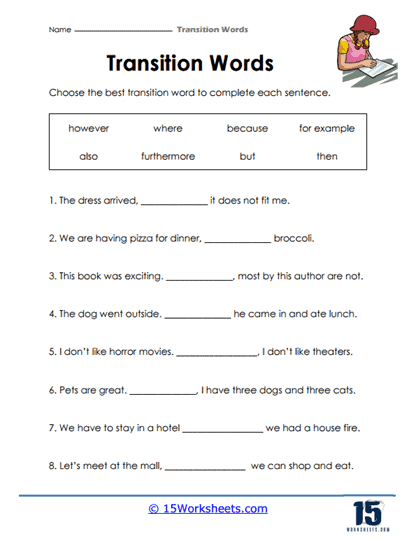
Choose The Best One
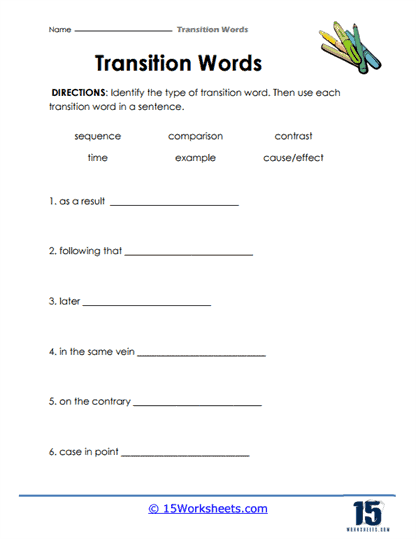
Identify And Use
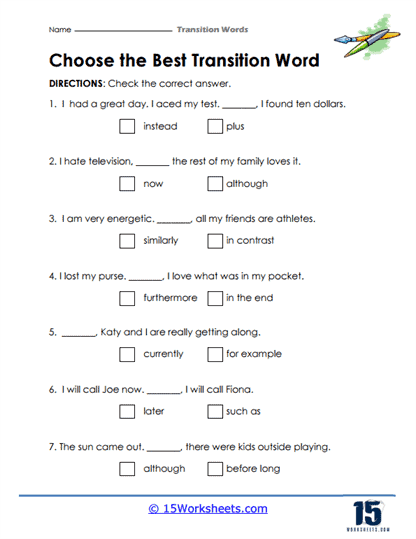
Check The Answer
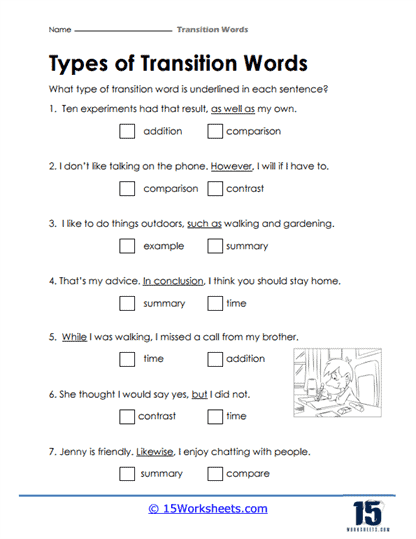
Which Type Is It?
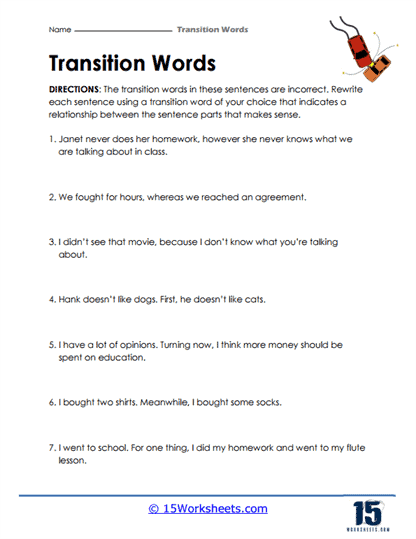
Rewriting Sentences
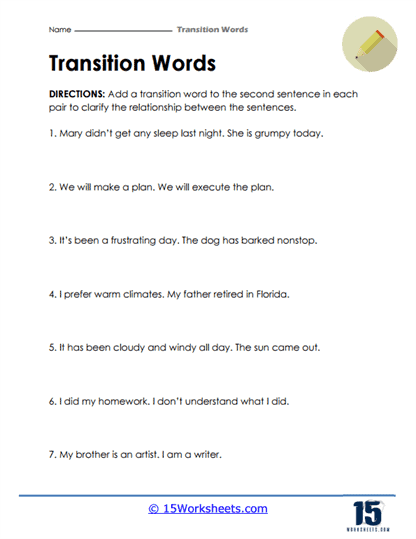
Clarify The Relationship
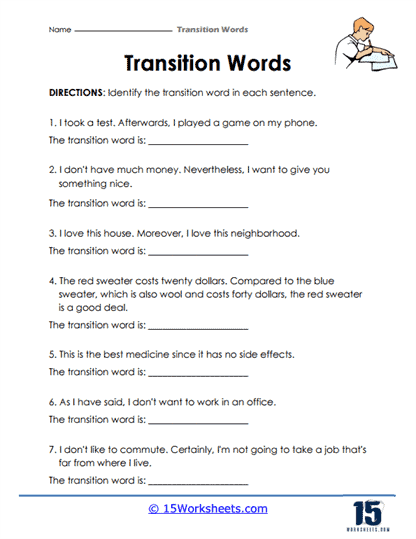
Find It In The Sentence
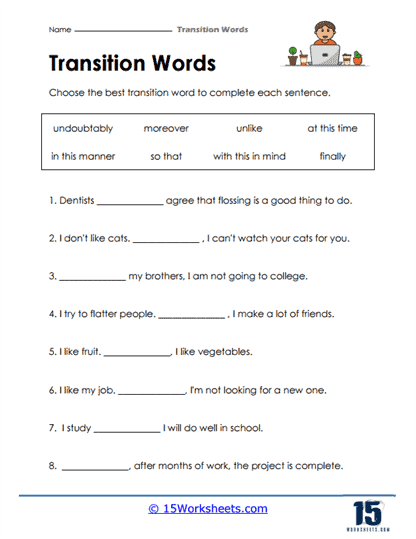
Complete The Thought
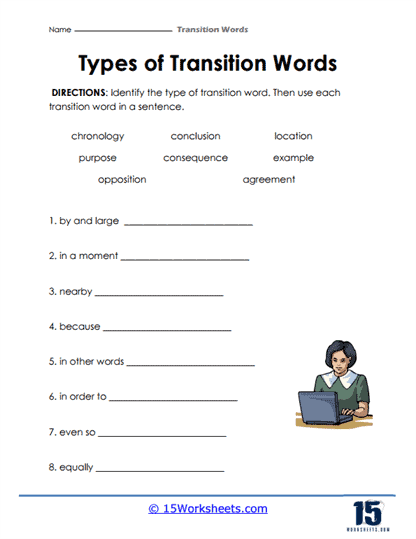
Learn The Types
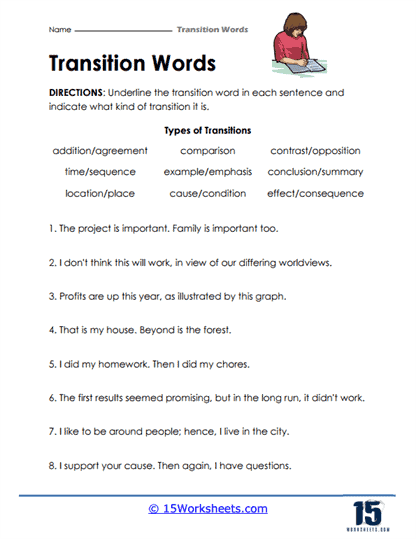
Underline And Indicate
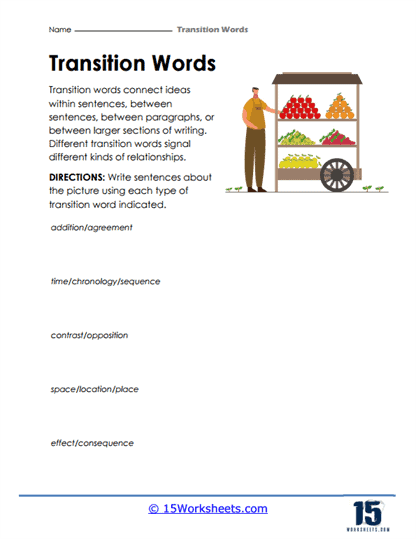
About The Picture
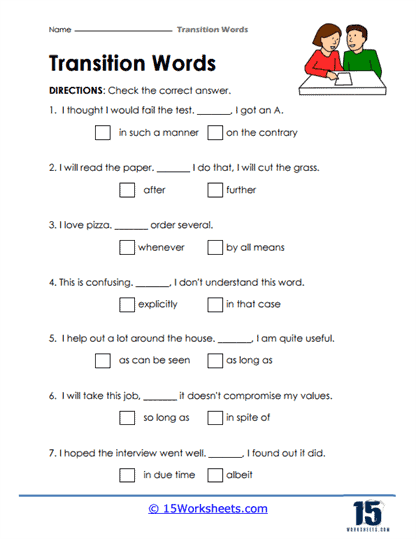
Tick The Right Box
All about these 15 worksheets.
This series of 15 worksheets on transition words offers a comprehensive and engaging learning experience for students to enhance their vocabulary, improve their writing skills, and strengthen their ability to create cohesive and well-structured compositions.
Through a variety of activities and exercises, students will develop an understanding of different types of transition words and their functions in writing. These worksheets promote critical thinking, effective communication, and the seamless flow of ideas. By completing them, students will:
- Be familiar with the different types of transition words and how they vary in function;
- Identify the transition words used in sentences;
- Write their own sentences about pictures shown using the indicated types of transition words;
- Classify a group of transition words according to their function, whether they are used to introduce major details, minor details, or for concluding a thought;
- Fill in the blanks with the appropriate transition words to complete the sentences;
- Rewrite sentences to reflect proper usage of transition words;
- And add transition words to pairs of sentences to clarify their relationship.
This series of worksheets on transition words equips students with the necessary tools to enhance their writing skills, improve coherence, and effectively convey ideas. By focusing on transition word identification, contextual usage, and critical thinking exercises, these worksheets develop students’ ability to create well-structured compositions, improve their reading comprehension skills, and enhance their overall communication proficiency.
Overall, through these worksheets, students gain a deeper understanding of the importance of transition words in guiding readers through their writing and producing cohesive, logical, and persuasive pieces of work.
What Are Transition Words?
In English literature, a transition word is a word that connects two parts of a text. Transition words help children put their words together to make a proper sentence that flows naturally. This is an important technique for students to learn as it introduces them to a lifetime of cohesive and clear writing. It helps them link phrases and words together to form smooth sentences and highlight different ideas and how they relate to each other.
Common transition words include “and,” “but,” “or,” and “so.” Transition words can be used to signpost the reader through a text, signal changes in tone or topic, or indicate shifts in time or location. With careful planning and deliberate use, transition words can be a powerful tool for creating an engaging and effective English literature essay.
Here is a sentence with no transition words:
- I saw a cat. Then, I petted the cat. Then, it ran away. Then, I went to school.
Here is a smoother sentence that uses transition words:
- I saw a cat and began to pet it, but soon, it ran away. So, I went to school.
This piece of text was improved because transition words were used to sew the sentence together.
Transition words are used in different scenarios to discuss different things:
- They are used to tell when, where, and how an event took place.
- They are used to describe things.
- They are used to compare things.
Importance of Transition Words
Transition words are important in writing for a number of reasons. First, they provide coherence by signaling the reader the relationship between ideas in a text. They also help to create flow and improve the overall readability of a piece. Finally, transition words can add variety and interest to writing by introducing new concepts or breaking up long stretches of text.
While transition words are not always necessary, they can be very effective when used well. When choosing transition words, selecting those that accurately reflect the relationship between ideas is important.
In addition, transition words should be used judiciously; too many can make writing seem choppy or difficult to follow. When used correctly, transition words can add clarity, interest, and variety to your writing.
Types of Transition Words
Transition words are important tools for writers. They help to create cohesion in a text, signal to the reader when one idea ends and another begins, and provide various other benefits. There are many different types of transition words, each with its unique purpose.
For example, conjunctive adverbs can be used to join together two independent clauses, while subordinating conjunctions can be used to introduce new information.
Additionally, transition words can be used to indicate whether a sentence is Contrasting, Summarizing, or Repeating previous information. By understanding the different types of transition words and their uses, writers can choose the best words to create cohesive and effective texts.
Examples of Transition Words to Better Understand How They Work
In English writing, transition words are used to connect different ideas or parts of a sentence. These words signal the reader that one idea is coming to an end and another is about to begin.
For example, the word “however” can be used to introduce a contrasting idea, while the word “furthermore” can be used to assert that something is true. In addition, transition words can also be used to show cause and effect or to provide an example.
Here are some examples of transition words that you can use in your own writing:
- However: Introduces a contrasting idea
- Moreover: Asserts that something is true
- Therefore: Shows cause and effect
- For example: Provides an example
Common mistakes when using Transition Words
One of the most common mistakes students make when using transition words is failing to use them appropriately.
Transition words are designed to signal a shift in thought or focus, but they can only do this if they’re used correctly. For example, many students will use a transition word at the beginning of a sentence but fail to provide any further context or explanation. As a result, the shift in focus comes across as abrupt and jarring.
Another common mistake is using too many transition words in a single sentence. This can make your writing seem choppy and difficult to follow. Instead, try to use transition words sparingly, using only as many as you need to signal the desired shift in focus.

Reading & Math for K-5
- Kindergarten
- Learning numbers
- Comparing numbers
- Place Value
- Roman numerals
- Subtraction
- Multiplication
- Order of operations
- Drills & practice
- Measurement
- Factoring & prime factors
- Proportions
- Shape & geometry
- Data & graphing
- Word problems
- Children's stories
- Leveled Stories
- Context clues
- Cause & effect
- Compare & contrast
- Fact vs. fiction
- Fact vs. opinion
- Main idea & details
- Story elements
- Conclusions & inferences
- Sounds & phonics
- Words & vocabulary
- Reading comprehension
- Early writing
- Numbers & counting
- Simple math
- Social skills
- Other activities
- Dolch sight words
- Fry sight words
- Multiple meaning words
- Prefixes & suffixes
- Vocabulary cards
- Other parts of speech
- Punctuation
- Capitalization
- Narrative writing
- Opinion writing
- Informative writing
- Cursive alphabet
- Cursive letters
- Cursive letter joins
- Cursive words
- Cursive sentences
- Cursive passages
- Grammar & Writing
Breadcrumbs
Transition words
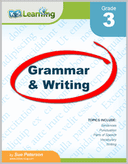
Download & Print Only $6.49
Linking ideas
Transition words and phrases link ideas and make writing more coherent. In these exercises, students use transition words from a word bank to complete paragraphs of text.

These worksheets are available to members only.
Join K5 to save time, skip ads and access more content. Learn More
More sentences worksheets
Find all of our sentences worksheets , from sentence fragments to simple, compound and complex sentences.
What is K5?
K5 Learning offers free worksheets , flashcards and inexpensive workbooks for kids in kindergarten to grade 5. Become a member to access additional content and skip ads.
Our members helped us give away millions of worksheets last year.
We provide free educational materials to parents and teachers in over 100 countries. If you can, please consider purchasing a membership ($24/year) to support our efforts.
Members skip ads and access exclusive features.
Learn about member benefits
This content is available to members only.
- Forgot Password?

IMAGES
VIDEO
COMMENTS
Common Transition Words and Phrases. In an effort to make our handouts more accessible, we have begun converting our PDF handouts to web pages. Download this page as a PDF: Transitions. Return to Writing Studio Handouts. Transitions clarify the logic of your argument by orienting your reader as you develop ideas between sentences and paragraphs.
start of a paragraph to show how the paragraph logically connects with the previous paragraph. This handout covers only transitional words and phrases. • Transitional words and phrases serve two purposes: 1. They clarify the relationship between sentences (e.g., whether a sentence elaborates on or gives an example ...
A transition between paragraphs can be a word or two (however, for example, similarly), a phrase, or a sentence. Transitions can be at the end of the first paragraph, at the beginning of the second paragraph, or in both places. Transitions within paragraphs: As with transitions between sections and paragraphs, transitions within paragraphs act ...
but, or, yet, so. These words can be paired with commas to combine two independent clauses into one full sentence—something that transitional phrases cannot do.) Information in this handout was adapted from Victor C. Pellegrino's 1987 book A Writer's Guide to Transitional Words and Expressions.
Transitional words and phrases can create powerful links between ideas in your paper and can help your reader understand the logic of your paper. However, these words all have different meanings, nuances, and connotations. Before using a particular transitional word in your paper, be sure you understand its meaning and usage completely and be sure…
Transition Words and Phrases Transition words and phrases are the easiest and most obvious transition devices. They act as signposts for your readers, guiding them along the path of your ideas. The remaining sections of this handout discuss words and phrases you can use to achieve specific connections between your thoughts. However, you should ...
Misused transition words can make your writing unclear or illogical. Your audience will be easily lost if you misrepresent the connections between your sentences and ideas. Confused use of therefore "Therefore" and similar cause-and-effect words are used to state that something is the result of, or follows logically from, the previous. Make ...
In this worksheet, your students will learn how to properly use transition words in a sentence. Grade Levels: 4th and 5th Grade, 6th - 8th Grade, Grades K-12. CCSS Code (s): W.5.2.c, W.6.2.c, W.7.2.c. Use our information and resources surrounding transition words for classrooms and learners everywhere! Printable worksheets on each category are ...
Transition Words, Spring 2011. Rev. Summer 2014. 1 of 3 Transition Words Transition words, also referred to as conjunctive adverbs, are found at the beginning of a sentence and create smooth flow from one sentence to the next. Transition words can be considered the glue that connects two related ideas. These words can be used to show time, make
word, a phrase, or a sentence. This handout will provide a list of commonly used transitional words and phrases that can be used in essays and paragraphs , and it will discuss when it is appropriate to use them. The charts in this handout will also designate when a comma should be used after specific transition words or phrase s.
While students can readily access a list of transition words from various ―how to‖ writing handouts, through this lesson the students should take ownership of their list by creating it as modeled by the teacher. The hope is that the students will refer to their own lists when needed more regularly than a prefabricated resource.
like, likewise, just, in a different way / sense, whereas, like, equally, in like manner, by comparison, similar to, in the same way, alike, similarity, similarly, just as, as in a similar fashion, conversely. 6. Illustration: use to develop or clarify an idea, to introduce examples, or to show that the second idea is subordinate to the first.
33 Transition Words and Phrases. 'Besides,' 'furthermore,' 'although,' and other words to help you jump from one idea to the next. Transitional terms give writers the opportunity to prepare readers for a new idea, connecting the previous sentence to the next one. Many transitional words are nearly synonymous: words that broadly indicate that ...
Transitions can be at the end of the first paragraph, at the beginning of the second paragraph, or in both places. 3. Transitions within paragraphs—As with transitions between sections and paragraphs, transitions within paragraphs act as cues by helping readers to anticipate what is coming before they read it. Within paragraphs, transitions ...
Here are some of the most common contrast transition words for essays, followed by examples: but. however. in spite of. on the one hand/on the other hand. in contrast. on the contrary. still. yet.
1 2. Your students will be transitioning into more mature writing in no time with these transition words worksheets! Students from kindergarten to fifth grade will expand their transition word vocabulary and learn how to use these words to connect their thoughts. With activities ranging from simple fill-in-the-blank exercises to integrating ...
This worksheet uses both "sequence" transitions and "cause and effect" transitions. 4th and 5th Grades. View PDF. Write Sentences With Transition Words. On this worksheet, students write sentences (or pairs of sentences) which try to incorporate the given transition words. Words include: therefore, finally, nevertheless, however, and otherwise.
About this Worksheet: Transition words are used in a sentence to connect two ideas. They join clauses or sentences together to show a difference or a connection. In this printable activity, students circle the transition words and phrases in the sentences below. Great for middle school but can be used where appropriate. Help your students ...
Different Transition Words and Their Impact. Transition words come in various forms, each serving a unique purpose in writing. Common transition words include "however," "moreover," "therefore," and "in addition." These words and phrases fall into several categories, such as addition, contrast, cause and effect, time, comparison, and conclusion.
Transitions words help smooth out one's writing. They allow one thought to flow to the next without making the reader notice. With enough practice, your student will learn how to use transition words in their writing. Use our worksheets, activities and games to help them master this most important part of speech.
This series of 15 worksheets on transition words offers a comprehensive and engaging learning experience for students to enhance their vocabulary, improve their writing skills, and strengthen their ability to create cohesive and well-structured compositions. Through a variety of activities and exercises, students will develop an understanding ...
Linking ideas. Transition words and phrases link ideas and make writing more coherent. In these exercises, students use transition words from a word bank to complete paragraphs of text. Worksheet #1 Worksheet #2. Worksheet #3. Similar: Write Declarative Sentences Write Imperative Sentences.